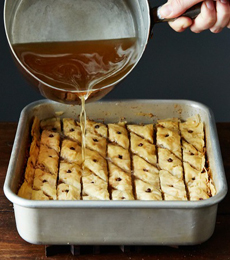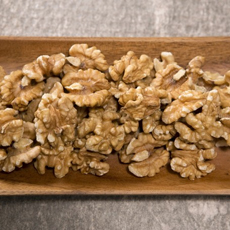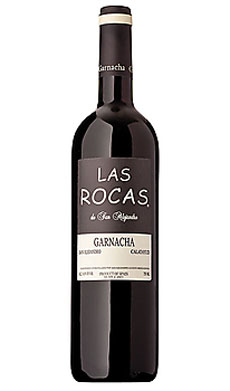|
When was the last time you cooked leeks?
Leeks are closely related to onions and shallots, although they are not interchangeable in recipes, as their flavors and intensities differ.
Leeks look like jumbo green onions (scallions). The long, thick stalks are mild. Leeks are hardier than onions and shallots, and are also more difficult to clean and cook. Unlike onions, leeks don’t produce bulbs or grow underground.
Onions come in many different shapes, sizes, colors and tastes, from sweet and mild to pungent, spicy and even acrid. Easy to grow, it is used in cuisines worldwide. The bulb grows underground, revealing itself by a single, vertical shoot above ground.
Shallots look like small yellow onions, a bit more oblong in shape. They grow underground. Their flavor is onion-like—sharper when raw but much more sweet and delicate when cooked, an onion-garlic hybrid. Like garlic, the bulbs grow in cloves. Unlike onions, shallots normally bloom white or violet flowers.
Leeks are often called “gourmet onions” because they are harder to find and costlier than onions. They can be prepared easily—boiled, braised, fried, sautéed or poached—or in elaborate recipes, or served raw as a milder substitute for onions.
|
|
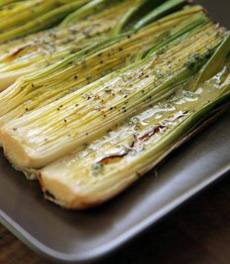
Roasted leeks are delicious, low in calories and easy to make. Photo courtesy La Tourangelle. |
|
The only rub is cleaning them. Leeks grow in sandy soil and don’t have a protective skin cover like onions and shallots; so you’ve got to be sure to get the sand out. Here’s a video showing how to clean leeks.
Leeks are available throughout the year, although they are in greater supply from the fall through the early spring. Purchasing tips:
While larger leeks may look more impressive, they are generally more fibrous in texture. Select leeks with a diameter of one and one-half inches or less.
In a recipe where the leeks are cooked whole (like the one below), select leeks that are of similar size to ensure consistent cooking.
Try this easy recipe from La Tourangelle, producers of the finest culinary oils and a NIBBLE Top Pick Of The Week. The recipe tastes extra-special using their Roasted Walnut Oil or Roasted Hazelnut Oil, but is certainly delicious with EVOO. You can serve it as a side or a first course.
RECIPE: ROASTED LEEKS WITH MUSTARD-TARRAGON VINAIGRETTE
Ingredients
1.5 pounds small leeks, trimmed, rinsed and halved lengthwise
2.5 tablespoons walnut oil, hazelnut oil or extra virgin olive oil
2 tablespoons white wine vinegar
2 teaspoons Dijon mustard
1/2 teaspoon minced garlic
1/2 teaspoon lemon zest
1 teaspoon coarsely ground black pepper
1 tablespoon roughly chopped fresh tarragon
|
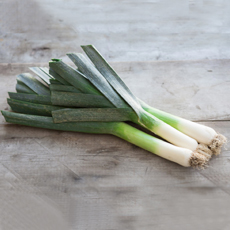
Leeks, fresh from the field. Photo courtesy
GoodEggs.com. |
|
Preparation
1. PREHEAT the oven to 350°F. Prepare an ice bath in a bowl.
2. BRING a 2-quart pot of salted water to a simmer over medium-high heat. Add the leeks and cook, stirring occasionally, until crisp-tender, about 5 minutes. Using a slotted spoon, transfer the leeks to the ice bath. Let chill completely, about 1 minute. Transfer the leeks to a paper towel-lined plate to drain about 3 minutes.
3. DRIZZLE the leeks with the oil and toss to coat. Place on a baking sheet or baking pan and roast the leeks until they become slightly golden brown, about 5 minutes. Meanwhile, in a medium bowl…
4. WHISK together the vinegar, mustard, garlic and lemon zest to make a vinaigrette.
5. REMOVE the leeks from the oven and transfer to a platter. Spoon the vinaigrette over the leeks and garnish with the black pepper and tarragon. Serve hot or at room temperature. Enjoy!
|
MORE LEEK RECIPES
Fried Leeks Garnish
Leek & Giblet Stuffing
Leek Soup
Leek & Seaweed Salad
Vichyssoise (leek and potato soup)
ABOUT LEEKS
Leeks are a member of the Allium genus, which includes garlic, onions, shallots, and scallions. Their botanical family, Amaryllidaceae, comprises herbaceous, perennial and bulbous flowering plants including the amaryllis, from which it takes its name.
Leeks look like large scallions, having a very small bulb and a long white cylindrical stalk of superimposed layers that flows into green, tightly wrapped, flat leaves. Cultivated leeks are usually about 12 inches in length and one to two inches in diameter and feature a fragrant flavor that is reminiscent of shallots but sweeter and more subtle.
Wild leeks, known as ramps, are much smaller in size, but have a stronger, more intense flavor. They are available for a short period of time each year and are often widely sought out at farmers markets when they are in season.
Believed to be native to Central Asia, leeks have been cultivated in there and in Europe for thousands of years. They were prized by the ancient Greeks and Romans and were thought to be beneficial to the throat. The Roman emperor Nero supposedly ate leeks everyday to make his voice stronger.
The Romans most likely introduced leeks to Britain; they were so esteemed in Wales that they became country’s national emblem. As the story goes, during a battle against that Saxons in 1620, Welsh soldiers placed leeks in their caps to differentiate themselves from the enemy—and won the battle, of course.
|
|
